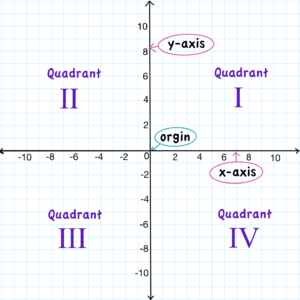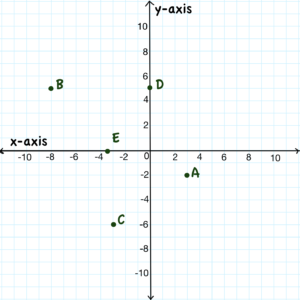Linear Equations and Graphing
In this video, step-by-step instructions on how to graph points on a coordinate plane are presented.
Graphing Points on a Coordinate Plane
The diagram below shows the different parts of the coordinate plane.
The point where the x-axis and y-axis intersect is called the origin.
Notice that x-values to the right of the y-axis are positive
and x-values to the left of the y-axis are negative.
Similarly, y-values above the x-axis are positive
and y-values below the x-axis are negative
An ordered pair of numbers is used to locate any point on the plane.
An ordered pair is enclosed in a pair of parentheses with the first number representing a location on the x-axis, the x-coordinate, and the second number representing a location on the y-axis, the y-coordinate, $(x,y)$. To locate a point on the coordinate plane, do the following:
| 1. | Start at the origin $(0,0)$. | |
| 2. | The first number is the x-coordinate. | |
| It tells the number of units left (negative) or right of the origin (positive). | ||
| 3. | The second number is the y-coordinate. | |
| It tells the number of units above (positive) or below of the origin (negative). |
Look at the coordinate grid below.The ordered pair for point A is $(3, -2)$. To locate point A, we move three units to the right and two units down. Also shown on the coordinate plane are points B, C, D, and E.
A little history:
When you graph points on a coordinate plain (also called a Cartesian coordinate system), you are using the work of René Descartes. Descartes (1596 – 1650) was a French mathematician, scientist and philosopher. His work provided the first systematic link between geometry and algebra.



